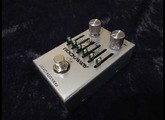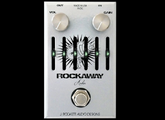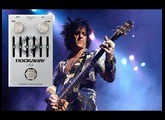« Rockaway Archer Improves Your Amp »
Published on 08/22/18 at 03:18
Best value:
Excellent
Audience:
Anyone
SOUND:
The YouTube video below demonstrates the capabilities of the Rockaway Archer, by Rockett Pedals, a transparent boost with an organic-sounding gain/drive and an EQ to help sculpt an ideal tone:
The Rockaway Archer was designed to drive your amp harder (meant to be last in your pedal chain and after all your drive/fuzz pedals), so that you can develop your tone further (via the EQ and Gain), to increase gain going into your amp and to boost the signal if warranted (and the pedal is very quiet considering how much boosting you can do). Even with the EQ flat and the Gain all the way down you can hear added harmonics and tonal definition previously not coming from your amp or pre-amp. The Gain can be very subtle, and you barely hear any added drive when turned up quarter way. Once the Gain is up half-way there is a distinct dirty addition in the mix, and as you turn up the Gain toward full capacity you notice how warm and it sounds with some delicious nastiness – absolutely no brittle harshness. You use the Volume knob as a Boost (upward of 18 dB cut or boost at six different EQ frequencies), although you can keep the Volume at parity with your amp and other equipment. What is most obvious is how clear the Boost is, whereas any tonal changes take place with the Gain and the six-band EQ, which provides a nice range of options without sounding exaggerated and harsh to the ears, e.g., pushing the bass or mids do not sound muddy and pushing the treble does not sound abrasive or sharp.
OVERALL IMPRESSION:
There are so many pedal manufacturers and pedals on the market that it’s always pleasant to be impressed, and Rockett Pedal’s true bypass Rockaway Archer definitely adheres to that sentiment. When you have a tone you like and then have the harmonics and note definition improve (with the tone standing out further in the mix), then it’s all good. This is true of clean, crunch or high-gain, as the Rockaway Archer does such a great job working in any environment. A signature pedal of Steve Stevens, a well-respected guitarist, his collaboration with Rockett Pedals makes the $249 price tag very reasonable once you integrate the Rockaway Archer on your pedal board. Amazingly what sounded good suddenly sounds a bit flat or ordinary when you remove the pedal, making the Rockaway Archer a definite keeper. The Gain is amazingly usable, whether left low or cranked high, and the EQ is one of the best I’ve used as the ranges for each frequency seem appropriate, whether turned high or low. In other words, you do not get an excessively low, mid or high response as you experiment with each frequency slider – but a potentially usable tone throughout the EQ’s entire spectrum. Other EQs I’ve tested worked well, as intended, but they also seemed to exaggerate too much lows (a strong ‘boom’ result) or produced shrill highs – in other words, the Rockaway Archer’s EQ fits exceptionally well within a guitar’s ideal frequency range.
EASE OF USE:
The easiest part on this pedal to use is the Volume, although adjustments will be required depending on where you set the Gain and the EQ (and whether each frequency is flat, a cut or a boost). The Volume can be used at parity, so that any tonal changes you create with the Gain and EQ are at the same level as your output without the Rockaway Archer, or you can set it so that you can boost your signal during lead solos or ‘heavier’ rhythm parts.
You will add some volume and high end to the signal with the Gain, and so you may need to adjust the Volume and EQ depending on what tone you’re chasing. The Gain increases in output and dirt relatively slowly and is not exaggerated, since it is used to add to or enhance what already is going on with your pedal board and amp – simply a very warm and organic sounding distortion. Even when playing ‘clean,’ you can up the Gain quarter way and it does not distort the signal, but seems to add to the fullness of the tone. As you approach half-way on the Gain you definitely hear added distortion, although not excessive. When working with high-gain amps, the Gain on the Rockaway Archer may be off completely, up slightly and likely not more than half-way. Cleaner amps will benefit from full Gain on the Rockaway Archer, particularly if you want to push a crunch tone or to shift from clean to crunch.
As you move the frequency sliders you will notice that the EQ is exceptional and everything seems to respond rather well, although in different ways. As stated previously, the EQ is highly usable as no matter where you place the lows, mids or highs it all seems to work well within a guitar’s overall frequency. The six-band EQ comprises the following, starting from lows (far left on the pedal) and moving to the highs (far right):
Band 1 – 100 Hz Far Left
Band 2 – 200 Hz
Band 3 – 400 Hz
Band 4 – 800 Hz
Band 5 – 1.6K
Band 6 – 3.2K Far Right
What you get is upward of 18 dB of cut and boost per frequency, which is why you may need to adjust both Volume and Gain depending on your EQ setup. Consequently, this is not an easy pedal to use, nor is it difficult. It will take 10-minutes to get the hang of it and dial in an awesome tone.
RELIABILITY & DURABILITY:
It is obvious that Rockett Pedals did not skimp on the construction of the Rockaway Archer. Its steel frame is incredibly hefty in weight and feel. The two knobs for Volume and Gain are steel as well, and feel very smooth and high-quality when turning. The EQ sliders have LEDs, which does increase any potential for damage, and so don’t stomp down like the giant chasing after Jack down the bean stock. The footswitch has a very solid ‘click,’ and you can tell its construction is of a high-quality. Further to the footswitch, this pedal has a ‘Speedswitch’ installed, which means when you remove the cover you can pop out one switch mechanism and plug in a new one… no re-wiring required… which is a nice touch that indicates one less thing (soldering of the switch) to go wrong. All cable inputs (power, TS in/out) are located in the back, which saves on pedal board space and potential strain from a stomping foot. It operates on a standard 9V DC 2.1mm tip jack power supply, drawing only 30mA
The YouTube video below demonstrates the capabilities of the Rockaway Archer, by Rockett Pedals, a transparent boost with an organic-sounding gain/drive and an EQ to help sculpt an ideal tone:
The Rockaway Archer was designed to drive your amp harder (meant to be last in your pedal chain and after all your drive/fuzz pedals), so that you can develop your tone further (via the EQ and Gain), to increase gain going into your amp and to boost the signal if warranted (and the pedal is very quiet considering how much boosting you can do). Even with the EQ flat and the Gain all the way down you can hear added harmonics and tonal definition previously not coming from your amp or pre-amp. The Gain can be very subtle, and you barely hear any added drive when turned up quarter way. Once the Gain is up half-way there is a distinct dirty addition in the mix, and as you turn up the Gain toward full capacity you notice how warm and it sounds with some delicious nastiness – absolutely no brittle harshness. You use the Volume knob as a Boost (upward of 18 dB cut or boost at six different EQ frequencies), although you can keep the Volume at parity with your amp and other equipment. What is most obvious is how clear the Boost is, whereas any tonal changes take place with the Gain and the six-band EQ, which provides a nice range of options without sounding exaggerated and harsh to the ears, e.g., pushing the bass or mids do not sound muddy and pushing the treble does not sound abrasive or sharp.
OVERALL IMPRESSION:
There are so many pedal manufacturers and pedals on the market that it’s always pleasant to be impressed, and Rockett Pedal’s true bypass Rockaway Archer definitely adheres to that sentiment. When you have a tone you like and then have the harmonics and note definition improve (with the tone standing out further in the mix), then it’s all good. This is true of clean, crunch or high-gain, as the Rockaway Archer does such a great job working in any environment. A signature pedal of Steve Stevens, a well-respected guitarist, his collaboration with Rockett Pedals makes the $249 price tag very reasonable once you integrate the Rockaway Archer on your pedal board. Amazingly what sounded good suddenly sounds a bit flat or ordinary when you remove the pedal, making the Rockaway Archer a definite keeper. The Gain is amazingly usable, whether left low or cranked high, and the EQ is one of the best I’ve used as the ranges for each frequency seem appropriate, whether turned high or low. In other words, you do not get an excessively low, mid or high response as you experiment with each frequency slider – but a potentially usable tone throughout the EQ’s entire spectrum. Other EQs I’ve tested worked well, as intended, but they also seemed to exaggerate too much lows (a strong ‘boom’ result) or produced shrill highs – in other words, the Rockaway Archer’s EQ fits exceptionally well within a guitar’s ideal frequency range.
EASE OF USE:
The easiest part on this pedal to use is the Volume, although adjustments will be required depending on where you set the Gain and the EQ (and whether each frequency is flat, a cut or a boost). The Volume can be used at parity, so that any tonal changes you create with the Gain and EQ are at the same level as your output without the Rockaway Archer, or you can set it so that you can boost your signal during lead solos or ‘heavier’ rhythm parts.
You will add some volume and high end to the signal with the Gain, and so you may need to adjust the Volume and EQ depending on what tone you’re chasing. The Gain increases in output and dirt relatively slowly and is not exaggerated, since it is used to add to or enhance what already is going on with your pedal board and amp – simply a very warm and organic sounding distortion. Even when playing ‘clean,’ you can up the Gain quarter way and it does not distort the signal, but seems to add to the fullness of the tone. As you approach half-way on the Gain you definitely hear added distortion, although not excessive. When working with high-gain amps, the Gain on the Rockaway Archer may be off completely, up slightly and likely not more than half-way. Cleaner amps will benefit from full Gain on the Rockaway Archer, particularly if you want to push a crunch tone or to shift from clean to crunch.
As you move the frequency sliders you will notice that the EQ is exceptional and everything seems to respond rather well, although in different ways. As stated previously, the EQ is highly usable as no matter where you place the lows, mids or highs it all seems to work well within a guitar’s overall frequency. The six-band EQ comprises the following, starting from lows (far left on the pedal) and moving to the highs (far right):
Band 1 – 100 Hz Far Left
Band 2 – 200 Hz
Band 3 – 400 Hz
Band 4 – 800 Hz
Band 5 – 1.6K
Band 6 – 3.2K Far Right
What you get is upward of 18 dB of cut and boost per frequency, which is why you may need to adjust both Volume and Gain depending on your EQ setup. Consequently, this is not an easy pedal to use, nor is it difficult. It will take 10-minutes to get the hang of it and dial in an awesome tone.
RELIABILITY & DURABILITY:
It is obvious that Rockett Pedals did not skimp on the construction of the Rockaway Archer. Its steel frame is incredibly hefty in weight and feel. The two knobs for Volume and Gain are steel as well, and feel very smooth and high-quality when turning. The EQ sliders have LEDs, which does increase any potential for damage, and so don’t stomp down like the giant chasing after Jack down the bean stock. The footswitch has a very solid ‘click,’ and you can tell its construction is of a high-quality. Further to the footswitch, this pedal has a ‘Speedswitch’ installed, which means when you remove the cover you can pop out one switch mechanism and plug in a new one… no re-wiring required… which is a nice touch that indicates one less thing (soldering of the switch) to go wrong. All cable inputs (power, TS in/out) are located in the back, which saves on pedal board space and potential strain from a stomping foot. It operates on a standard 9V DC 2.1mm tip jack power supply, drawing only 30mA



